Letters from Lodi
An insightful and objective look at viticulture and winemaking from the Lodi
Appellation and the growers and vintners behind these crafts. Told from the
perspective of multi-award winning wine journalist, Randy Caparoso.
Story of an appellation—Part 1, the first stewards of the land that would become Lodi
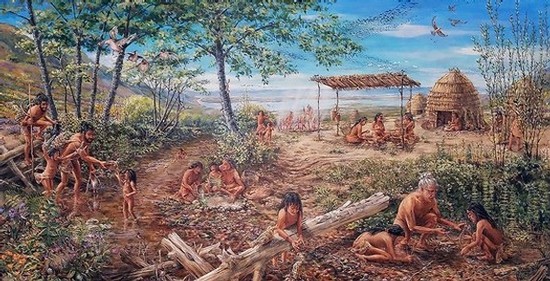
2019 mural depicting Miwok tribal life, established over a span of 5,000 years, during the early 1800s. Amy Hosa and Linda Yamane, San Mateo County Historical Association.
We never tire of telling the story of the Lodi appellation. Why should we? It is a history as rich and compelling as the ultra-fine sandy loam soils—the deepest and most consistent, by far, in the entire state of California, for that matter the entire U.S.—surrounding the City of Lodi.
It is also a story of an appellation whose history goes as far back as any wine region, bar none, in California. Think about it: California became a state in 1850, at a time when the so-called forty-niners were pouring into the Sierra Nevada foothills from around the world to seek their fortune in gold.
The vast majority of fortune hunters did not strike it rich, so they did the next best thing—fanning out into the flatter regions stretching from Sierra Nevada to the San Francisco Bay to stake their claims as farmers or ranchers. Many of them, of course, were of European lineage, and Europeans drink wine, which requires grapes.
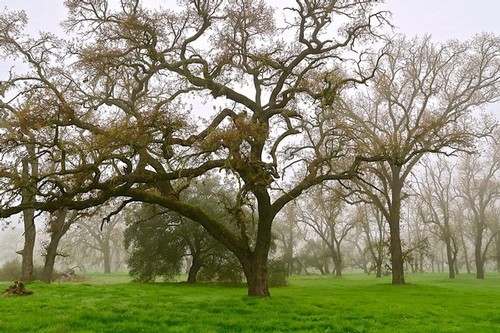
This recent photo of a valley oak grove, privately conserved by Jessie's Grove Winery, is almost exactly how the Lodi Viticultural Area looked like before the arrival of people of European descent in the early 1800s; a landscape dominated by grasslands and deeper-rooted species of oak between teeming rivers and marshes.
Hence, by 1852 the first vineyards were being planted everywhere possible in the newly minted state, from the higher elevation Mother Lodi Country in Amador County to hillsides adjoining Sonoma and on the valley floor near the town of Napa... and in between, in the lush, Delta influenced region where Native Americans once hunted and gathered—the latter, eventually recognized (in 1986) as an official wine appellation, the Lodi AVA.
But let's not get ahead of ourselves. Let's take our time telling the story of the appellation in several parts, with plenty of illustrations, beginning with the days when the region was still known as something of a classic Wild West territory, still tagged with a nearly unpronounceable native American name—Mokelumne, a rough translation from the Indigenous Miwok language constructed from moke (for "fish net") and one (suffix for "people of"). Mokelumne, for the record, is typically pronounced moa-KEL-um-nee.
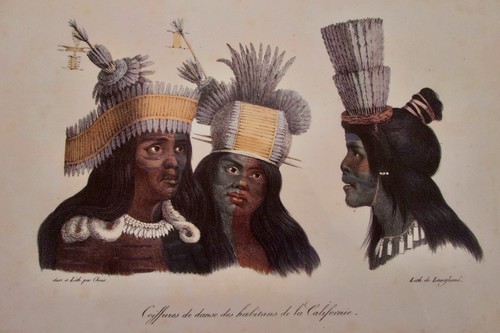
Early 1800s Lewis Chloris illustration of Plains Miwok (known for practicing body painting and tattooing) indigenous to the area between the Cosumnes and Calaveras Rivers now known as Lodi.
The sustainable culture of the Plains Miwok, the first Lodians
The first settlers of European descent arrived in Mokelumne (which would not become known as Lodi until 1874) in 1846, finding what Ralph A. Clark, in Lodi—Images of America, described as "an abundant paradise." It is perched just a few feet above sea level, sandwiched between the lower foothills of the Sierra Nevada mountain range to the east, and the lower elevation, freshwater marshland of the Sacramento-San Joaquin River Delta and the narrow tidal Carquinez Strait to the immediate west.
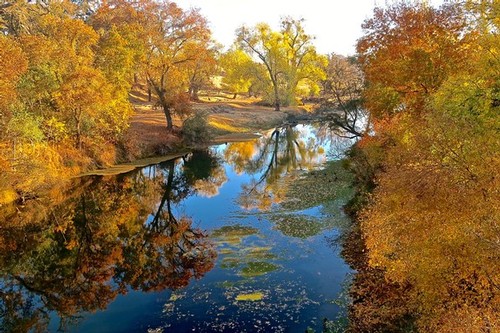
The Mokelumne River, in Clements Hills east of the City of Lodi, is a far more sedate and considerably less bountiful waterway (held back by two dams between Lodi and the foothills) than it was during the last days of the Plains Miwok in the late 1700s.
The Carquinez Strait connects Suisun Bay, where the Sacramento and San Joaquin Rivers flowing down from the Sierra Nevada meet before spilling into San Pablo Bay, the northern extension of San Francisco Bay. The entire Sacramento-San Joaquin River Delta dates back approximately 10,000 years when seismic activity drained the freshwater lake that covered the entire San Joaquin Valley into the Pacific Ocean. With most of its elevation lying at least 15 feet below sea level, the Delta area is the only break in the entire California Coast Ranges and hence exerts a huge impact on the climate of the farmlands surrounding the City of Lodi that are directly adjoining.
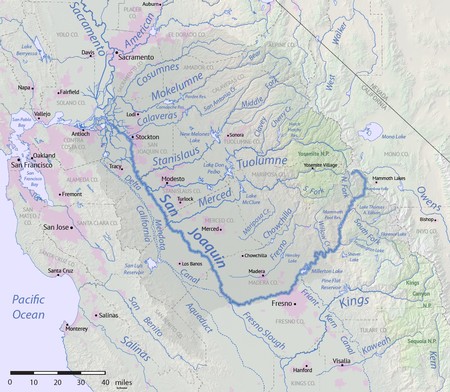
The San Joaquin River watershed, analogous to the San Joaquin Valley, was once covered by an inland sea and then, starting about 2 million years ago, by a freshwater lake after marine outlets were closed by the uplift of coastal ranges.
The Native American tribe occupying this plush pocket of riparian growth just prior to the onslaught of settlers from Europe and other states was the Plains Miwok, who had lived in this riverside area for a staggering 5,000 years. In fact, there is evidence that humans were already living in this region of California by the end of the last Ice Age, as long ago as 13,000 years, when the ocean was 300 feet lower and the Delta and San Francisco Bay were physically nonexistent.
Fast-forward to 2023: One of the greatest achievements of the Lodi winegrowing industry is its influential system of sustainable farming, known as LODI RULES for Sustainable Winegrowing. It is so highly regarded that more than half the vineyards now certified by LODI RULES are not even located in Lodi; it is followed in other appellations of California, Washington as well as Israel.

Feature photo of Lodi's Dr. Stephanie Bolton published by Wine Enthusiast magazine. Meg Smith.
Interest in Lodi's sustainable program around the world, in fact, is so intense that just over the past year Dr. Stephanie Bolton—Lodi Winegrape Commission's Grower Research and Education Director—has been invited to speak in Uruguay, Cyprus, Canada, New Zealand, Indonesia, Japan and Australia (while also speaking in virtual conferences taking place in France and Argentina) on the subject of sustainability.
This past August, Dr. Bolton was recognized as one of Wine Enthusiast magazine’s “Future 40 Tastemakers & Innovators of 2023” specifically for her industry-wide leadership and tangible achievements in the areas of sustainable winegrowing and viticulture science. Dr. Bolton herself, however, would be the first one to credit the Lodi growers themselves—many of them from families that have been farming in the region since the 1800s or early 1900s—for initiating the research and organizing their own sustainable practices, starting in the early 1990s (re Firsthand detailed history of Lodi's groundbreaking sustainable winegrowing program).
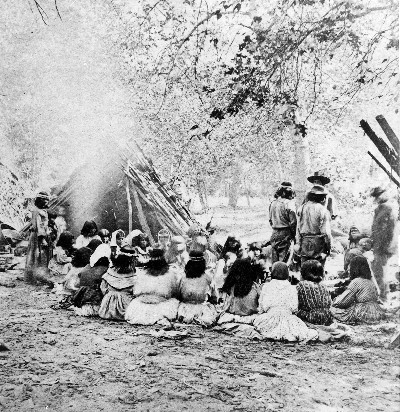
1972 Miwok camp.
There is, perhaps, something about Lodi itself that engenders this consciousness. Contrary to many of our assumptions, the Plains Miwok, the region's original inhabitants, were not passive hunter-gatherers sustained entirely by the grace of Mother Nature. Rather, they were pro-active, conscientious stewards of the land. There is a wonderful visual display at the San Joaquin County Historical Museum in Lodi's Micke Grove Regional Park which tells their story: How the Plains Miwok were known to practice selective burning, pruning, weeding, digging, harvesting, and sowing, and cared for hundreds of species of plants supplying their food, medicine and raw materials for their way of life.
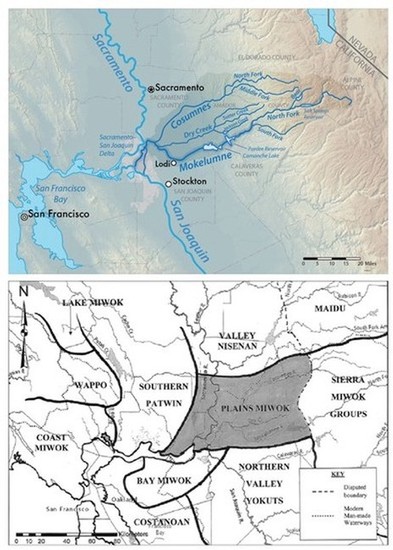
Modern-day Mokelumne River-Lodi watershed markers (above) outline the historical territories of the Miwok and Yokut tribes.
The Miwok also played an active role in the habitats of the animals and birds important to their lives. Their life among the fresh-water marshes along the rivers called for periodic burning and management of the tules (bulrushes) and cattails utilized for food, baskets, clothing, houses, boats, and other purposes. Low intervention maintenance of marshland also helped to sustain open water for fish, salmon, and Pacific Flyway waterfowl. They netted and trapped ducks and geese in the marshes, and quail and other birds in the woodlands. They also hunted deer, tule elk, pronghorn antelope, rabbits, and other animals sharing this river environment.
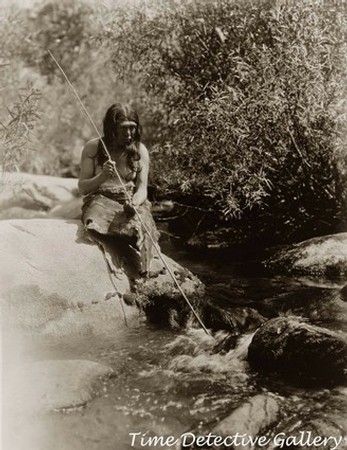
1924 print of Miwok fisherman.
These sustainable practices are echoed in multiple aspects of today's LODI RULES for Sustainable Winegrowing; particularly the restoration of native riparian flora and fauna aggressively pursued by generational family-driven companies such as Vino Farms, LangeTwins Family Winery & Vineyards, and Heritage Oak Winery.
One of the most majestic natural resources of the Mokelumne River watershed area was Quercus lobata, known as the valley oak. This species of oak is endemic to areas of California where the soil is deep, rich, and replete with water, and there is no area in the state where the soil is deepest, richest, and has the most immediate access to water than the vicinity of the Mokelumne River between the Sierra Nevada and the California Delta.
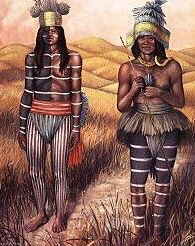
Illustration of feathered and tattooed Miwok in Harry Knill's book, Great Indians of California.
Not coincidentally, once people of European descent arrived with their need for grapevines, they were immediately cognizant of the region's natural resources that made it easiest to cultivate varieties of Vitis vinifera such as Zinfandel and Flame Tokay. They found if they planted grapevines a few miles to the north, or to the west or east, where the soil had a shallower hardpan, and trees or oaks other than Quercus lobata were better adapted, they found that vineyards simply did not yield as much return.
Simply put, where valley oaks thrived, so did grapevines. Hence, the original terroir in which the table grape and winegrowing industry thrived was the region now identified as the Mokelumne River AVA—defined by ultra-fine yet high-vigor sandy alluvium as deep as 100 feet—surrounding the City of Lodi. This specific terroir, as it were, explains why there are more old vine growths in the Lodi AVA than in any other wine region in California and the entire country—environmental health going hand in hand with healthy vines capable of sustaining productivity for over 50 or 100 years.
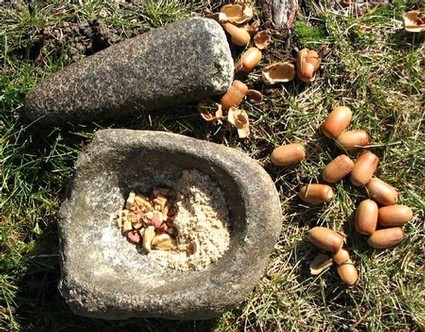
Miwok stone mortar and acorns.
The diet of the Plains Miwok primarily consisted of the acorns of valley oaks, although they also subsisted on the rich seeds of many grasses and wildflowers in the surrounding grasslands. Acorns were stored and eaten all year round. Each family harvested an estimated 2,000 pounds each fall. The nuts were cracked and hulled, then pounded into flour; hot water poured through the flour to remove the bitterness. The acorns were consumed in several ways; primarily, dried like bread or heated in baskets to prepare mush or soup.
The native Americans were also known to practice fire conservation. Fires were meticulously set by tribal caretakers to keep out shrubs and trees where grasslands were preferred. It was also found that judicious pruning and controlled fires also helped to prevent crowding of valley oaks, producing older, rounder trees capable of producing more acorns.
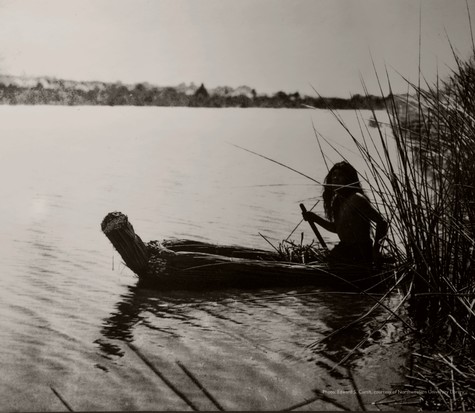
Photo of Plains Miwok in canoe constructed from native tule.
As written by artist Kathleen Rose Smith, a Bodega Miwok/Dry Creek Pomo and member of the Federated Indians of Graton Rancheria:
Living in spiritual and physical balance in the same small areas for thousands of years without feeling the need to go somewhere else, as was the case with my people, required restraint, respect, and knowledge of the ways of each animal and plant. By managing the land—burning it, pruning it, digging it properly—we enhanced the growth of the plants that sustain us, and the animals upon which we rely.
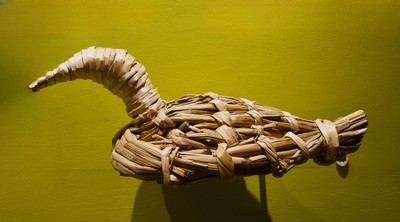
Miwok duck decoy woven from tule.
Gold Rush years, and the final disappearance of Plains Miwok
Before the early 1800s arrival of American trappers—who established French Camp in 1832 (San Joaquin Valley's first historical settlement of non-natives)—the bountiful landscape between the Delta and the Sierra Nevada is said to have been the most densely populated area in North America north of Mexico. By 1932, many of the Miwok tribes had already succumbed to a malaria epidemic that ravaged the indigenous populations.
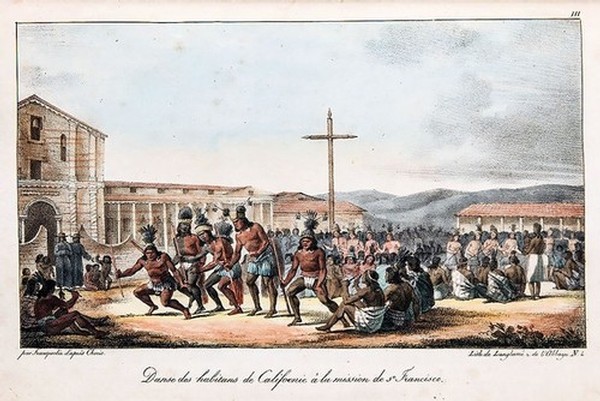
Native dancers in traditional Miwok headbands at a Franciscan Mission in 1816 lithograph by Louis Choris.
By 1835 most of the Plains Miwok were moved, voluntarily or forcibly, to the Franciscan order's Mission San José or Mission Santa Clara de Asís. Even after the Alta California missions were secularized in 1838, John Sutter, who founded Sutter's Fort in the area that became Sacramento, was said to have played off the few surviving Plains Miwok families against other groups to successfully gain control of their lands.
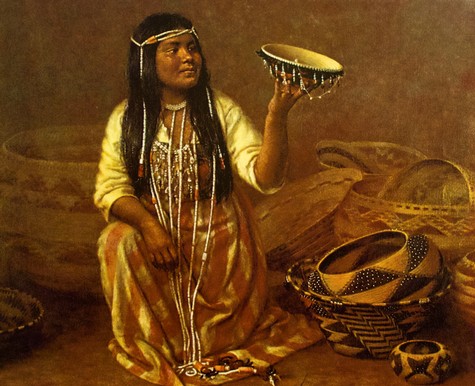
Depiction of Miwok chiefs, who are said to have been both female or male. San Joaquin County Historical Museum.
The Treaty of Guadalupe Hidalgo, signed on February 2, 1848, to end the Mexican-American War, turned Alta California over to the United States. But what really transformed the landscape was the January 24, 1848 discovery of gold at Sutter's Mill, in the foothills of the Sierra Nevada less than a day's horseback ride from the early trappers' camps on the valley floor along the banks of the Mokelumne River. This historic event unleashed a human tide of hundreds of thousands of new settlers, eager to put down roots in this new American state, California having been admitted into the Union on September 8, 1850.
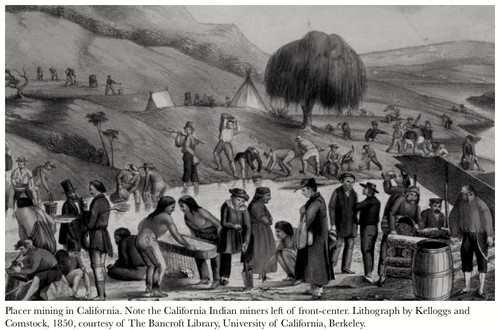
1850 lithograph showing Miwok working alongside Anglo miners in the Placer area.
Gold was not considered something of value to native people. Once foreigners swooped in, the Sierra and Plains Miwok became aware of the trade value of gold, and many of them knew exactly where to find it. In the first few months of the Gold Rush, some natives worked for miners, and some mined on their own. Circumstances quickly changed, however, and natives were barred from independent prospecting. Instead, they were driven from their homes and ancestral lands, their hunting and fishing grounds were defiled if not decimated by the damming of waterways, and invariably, they were targeted for forced labor or worse.
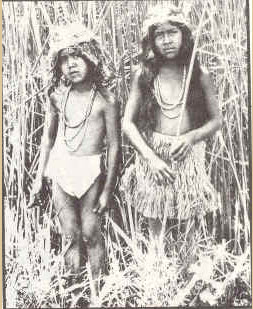
1800s photograph of Miwok children.
In the end, the Gold Rush devastated California's native population. The numbers of Miwok and neighboring Yokut tribes in the San Joaquin Valley area were reduced from an estimated 150,000 in 1847 to only 30,000 by 1870. The non-Anglo population grew; particularly groups such as the Chinese—an estimated 25,000 Chinese (the largest group of foreigners in California) had come to the foothills to help mine for gold, working mostly as lower-paid laborers.
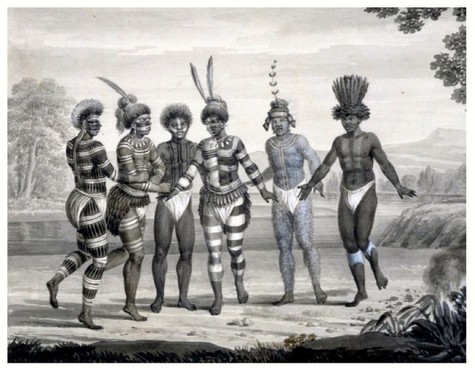
Early 1800s illustration of Plains Miwok men.
After California was ratified as a state in 1850, treaties setting aside lands for Miwok tribes were signed, but these treaties were never honored. In 1906, Congress passed legislation to establish 54 rancherias—federal lands designated for aboriginal settlement—in California. In addition, small tracts of land were acquired in northern and central parts of the state to establish what is now known as the Rancheria System of California.
Today, what little remains of people with varying degrees of Miwok or Yokut blood live in either these rancherias or sovereign intertribal lands such as the Round Valley Reservation in Mendocino County, or are spread out in towns throughout Northern California. They are everywhere, it seems, except in the lush natural environment of their original home between the Delta and the Sierra Nevada.
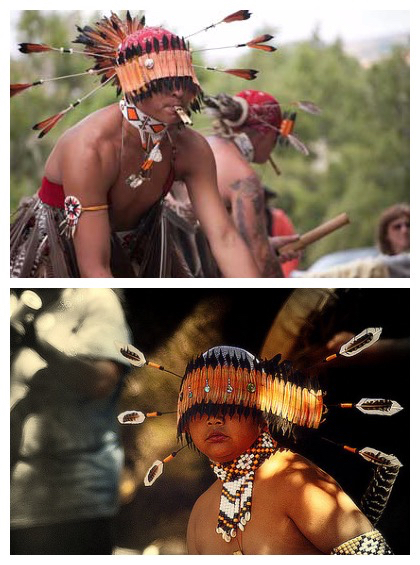
Modern-day demonstration of Miwok dance in ceremonial attire. California Indians and The Miwok People of California.